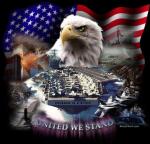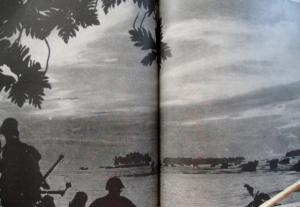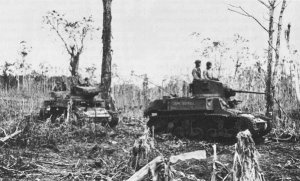July 1943
| 1. Kolombangara Island where Capt. Cecil and others were rescued July 7, 1943 2. Kula Gulf were the CL 50 was sunk July 6, 1943 3. Vella Lavella were 165 officers and men were stranded be be rescued July 16, 1943 4. Ranongga Island were the remains of General Preston Douglas S1c USS Helena CL 50 were found in 2006. 5. Blackett Stright were John F. Kennedy’s PT 109 was sunk August 2, 1943. 6. Randova Island PT 109’s base. |
The information and map above provided by Shipmate Charlie McClellend, USS Helena CL-50.
For the landing on New Georgia, Admiral Turner’s attack force (Task Force 31) consisted of ships and landing craft from the South Pacific or III Amphibious Force (Task Force 32), plus the ground troops. These troops, designated the New Georgia Occupation Force, initially included the following units:
43rd Division
9th Marine Defense Battalion
1st Marine Raider Regiment (less two battalions)
136th Field Artillery Battalion (155mm. howitzers), 37th Division
Elements of the 70th Coast Artillery Battalion (Antiaircraft)
One and one-half naval construction battalions
Elements of the 1st Commando, Fiji Guerrillas
Radar units
Naval base detachments
A boat pool
5-6 July – The first run by the Japanese, with 2,400 troops was intercepted by RAdm. Ainsworth with 3 light cruisers ; the USS Helena, St. Louis and Honolulu, and 4 destroyers of TF-18, the Nicholas, O’Bannon, Radford and Jenkins. This was labeled the Battle of Kula Gulf. (link for further detailed info)
As visibility was down to 7,000 yards, the IJN destroyer and flagship Niizuki sank with Adm. Akiyama on board. The Suzukaze and Tanikase received damaged, but remained in the battle. Three torpedoes hit the USS Helena and also the destroyer, Strong. The Japanese ships, Satsuki and Nagatsuki, raced to Vila to unload their men and cargo; the Nagatsuki was later sunk. After the battle, other enemy ships unloaded their cargo while rescue missions commenced on both sides.
13 July – The second Japanese supply convoy came at night off Kolombangara Island. The enemy skill of night flying and detecting radar signals was made apparent. TF-18 sank the flagship cruiser of RAdm. Tanaka, the Jintsu, but lost the destroyer Gwyn and the New Zealand cruiser Leander was heavily damaged. About 2,000 additional Japanese were put ashore on New Guinea, while the Australian troops took the Mumbo enemy stronghold.
15 July – The Japanese had 45 aircraft downed over Rendover at New Georgia. The Americans lost 3 planes.
17 July – in the Solomon Islands, more than 200 Allied aircraft, including B-17s made a 12 hour attack on Japanese shipping and military positions in and around Bougainville. This successful action downed 49 enemy planes in the air and destroyed many more on land at Kahili airfield. Dauntless dive-bombers and Avenger torpedo bombers took out 7 vessels in Buin-Faisi Harbour, including a light cruiser and a destroyer at a cost of 6 aircraft.
25-31 July – US forces at New Georgia began an offensive attack. Enemy troops, in camouflaged pillboxes needed to be pried out with tanks and flamethrowers. Such areas as Horseshoe Hill were taken and then lost after bloody hand-to-hand combat. On the 29th, MGen. Hester was replaced by MGen. John Hodge as commander of the US 43rd Division and there would 10 more days of close combat.
CBI Report of a Paratrooper taking down a Zero….
###############################################################################################
Current News –
Locating the Japanese pilot downed in Australia…
German U-boat 168 located off Jakarta (Once known as Batavia, Dutch West Indies) – The Daily Mail, reported that divers off the Indonesian coast had discovered a Nazi U-boat wreckage of WWII with at least 17 skeletons of its lost crew aboard. According to the initial findings, it is the U-168, the German type IX C/40 U-boat commissioned on 10th September 1942 and was commanded by Captain Helmuth Pich.
##########################################################################
Military Humor –
#######################################################################################################
Farewell Salutes –
Chuck Barker – Tacoma, WA; USMC, WWII, PTO
Marc Diab – Ontario, CAN; RC Army, Afghanistan, Royal Canadian Dragoons
Jack Franklin – Irving, TX; US Army Air Corps, WWII, PTO, 187th Regiment/11th A/B
Cyril Hill – Hawke’s Bay, NZ; NZ Army # 644920, Korea, 16th Field Regiment
Joseph Islas – Clarksville, TN; US Army Air Corps (Ret.), WWII, PTO, 11th Airborne
Constance Kimberling – Augusta, ME; US Army (DAV), Vietnam
Hyrum Mathews – Shelley, ID; USMC, WWII, PTO, Silver Star, Purple Heart
Leonard Melley – Ridgewood, NJ; US Navy, WWII
Walter Roberts – Daleville, AL; US Army (Ret. 20 Years), WWII, Korea, Vietnam
Mal Whitfield – Los Angeles, CA; US Army Air Corps, WWII, Sgt. Tuskegee Airmen / ’48 Olympic Gold-Medalist / Korea, tail gunner / ’52 Olympic Gold & Silver
################################################################################
Posted on November 30, 2015, in Uncategorized, WWII and tagged 1940's, Army, family history, History, Japan, Military, Navy, Pacific, USA, veterans, WW2, WWII. Bookmark the permalink. 32 Comments.














Reblogged this on Momentary Lapse Of Sanity.
LikeLiked by 1 person
Thank you.
LikeLike
I came across this today. USS Helena found.
https://www.msn.com/en-us/news/world/missing-us-ww2-warship-found-in-pacific-ocean/ar-AAvW1T7?ocid=spartandhp
LikeLiked by 1 person
Thank you, Rose, I hadn’t seen this yet! Paul Allen’s team sure has been busy – and successful lately!!!
LikeLiked by 1 person
You’re welcome. Hopefully these discoveries on the news will result in an awareness among the young generation of what went on during the war and appreciate the freedom we have today.
LikeLiked by 1 person
Hopefully they will learn the history and appreciate what those sacrifices mean.
LikeLiked by 1 person
I read here so much things i never didn’t known.Hope now with the new president there not will come a WOIII
LikeLiked by 1 person
We all thought that with Obama and Bush too. So, don’t worry.
LikeLike
That map still tells a story to this day, remnants of all those battles are still in situ today, rusted pieces of machinery, that once was the difference between life and death.
Papua Nieu Guinea has many dotted throughout the highlands.
Great post gp.
LikeLiked by 1 person
That island was basically in the dark ages back then – it should have been left that way! Humans leave garbage wherever they go….
LikeLiked by 1 person
Reblogged this on Ancien Hippie.
LikeLike
Thank you very much, Penny!
LikeLike
Couldn’t open the “not easy being a pilot” one … I kept getting the “Fleet’s in, Honey” one instead.
But good news, the Honey one opens properly when clicked.
LikeLike
Thanks for letting me know!
LikeLike
Your ‘Farewell Salutes’ include Mal Whitfield, whose life story is very inspiring. He was a member of the Tuskegee Airmen inWWII, and he also flew combat missions in Korea as well. After his service, he did a lot of work to help coach athletes in several African countries, helping several to enter the Olympics. He also won five Olympic medals as a sprinter too!
LikeLiked by 1 person
Yes, I tried to show that with the Olympic mention between wars and after. Mr. Whitfield was actually an active sergeant when he won his first medals. Thank you for reading and honoring the Farewell Salutes, they represent the thousands of others that served with them.
LikeLiked by 1 person
Very interesting and well laid out. So many facts that I did not know. Smiling at the humor section especially ” You think it’s easy being a pilot? “
LikeLike
Thanks, Kathy.
LikeLiked by 1 person
Much appreciate your recounting of the Solomon’s Campaign. Brings back memories of hearing this news over the radio and seeing film clips in newsreels. Keep up your outstanding work. In Navy parlance: Bravo Zulul
LikeLiked by 2 people
I know Europe was the media’s main concern once Guadalcanal was finished, but it’s great to hear that the radio had some coverage. I appreciate you visit, Martin.
LikeLike
Frightening, as always. What a battle.
LikeLike
And, this all happened when the newspapers of the day felt there wasn’t enough action to be bothered writing about and concentrated on Europe. Thanks for being one who wants to know the whole story, Jacqui.
LikeLike
Interesting stuff. I’m always amazed at how much action took place in one small group of islands.
LikeLiked by 1 person
Isn’t that the truth. And this is the year that basically gets overlooked by historians in their huge tomes of “knowing” the Pacific War!!
LikeLiked by 1 person
I do hope that they will leave Captain Pich and his crew alone. The last thing needed would be treasure seekers and war grave desecrators. After all, the U-boats were among the least vile of the German armed forces, along with the Luftwaffe.
LikeLiked by 1 person
I know the US Navy tradition is to leave the remains where they are as their final resting place, but what is happening here – I can’t say. I have a feeling everything will be removed.
LikeLike
This war was so complicated. Just keeping track of the numbers had to be hard. I had to reread parts of this post. Thanks for the careful gathering and interesting sharing of information.
LikeLiked by 1 person
Don’t feel like you’re the only one, Dan! I have to go over and re-read, re-write, double-check till I am crossed-eyed!!!! Thanks for taking stock of the situation!
LikeLiked by 1 person
So many islands, so much hard fighting. I can only imagine how impossible it would have been to fight on the islands of mainland Japan, had the atomic bombs not ended the Pacific War.
Best wishes, Pete.
LikeLike
Actually Hiroshima didn’t have much standing when the A-bomb was dropped. It was an expensive program that had to justify its expense and gave the Emperor the push he needed to to speak up and demand surrender.
LikeLiked by 2 people
Thank you, Angel.
LikeLike
Pingback: My Article Read (11-30-2015) | My Daily Musing